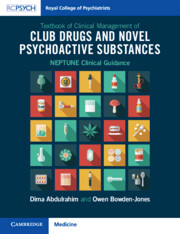 Textbook of Clinical Management of Club Drugs and Novel Psychoactive Substances
Textbook of Clinical Management of Club Drugs and Novel Psychoactive Substances Book contents
- Textbook of Clinical Management of Club Drugs and Novel Psychoactive Substances
- Textbook of Clinical Management of Club Drugs and Novel Psychoactive Substances
- Copyright page
- Contents
- Acknowledgements
- Part I Introduction and Background
- Part II Drugs with Primarily Depressant Effects
- Part III Drugs with Primarily Stimulant Effects
- Part IV Drugs with Primarily Hallucinogenic Effects
- Part V Synthetic Cannabinoid Receptor Agonists
- Chapter 13 Synthetic Cannabinoid Receptor Agonists
- Part VI Concluding Remarks
- Index
- References
Chapter 13 - Synthetic Cannabinoid Receptor Agonists
from Part V - Synthetic Cannabinoid Receptor Agonists
Published online by Cambridge University Press: 06 October 2022
- Textbook of Clinical Management of Club Drugs and Novel Psychoactive Substances
- Textbook of Clinical Management of Club Drugs and Novel Psychoactive Substances
- Copyright page
- Contents
- Acknowledgements
- Part I Introduction and Background
- Part II Drugs with Primarily Depressant Effects
- Part III Drugs with Primarily Stimulant Effects
- Part IV Drugs with Primarily Hallucinogenic Effects
- Part V Synthetic Cannabinoid Receptor Agonists
- Chapter 13 Synthetic Cannabinoid Receptor Agonists
- Part VI Concluding Remarks
- Index
- References
Summary
Synthetic cannabinoid receptor agonists (SCRAs), also referred to as synthetic cannabinoids, or synthetic cannabimimetics, are a large group of smokeable drugs initially sold as legal alternatives to cannabis. They have a strong effect on the endocannabinoid system. More than 200 different SCRA compounds were available in Europe at the end of 2020.
- Type
- Chapter
- Information
- Textbook of Clinical Management of Club Drugs and Novel Psychoactive SubstancesNEPTUNE Clinical Guidance, pp. 299 - 328Publisher: Cambridge University PressPrint publication year: 2022


